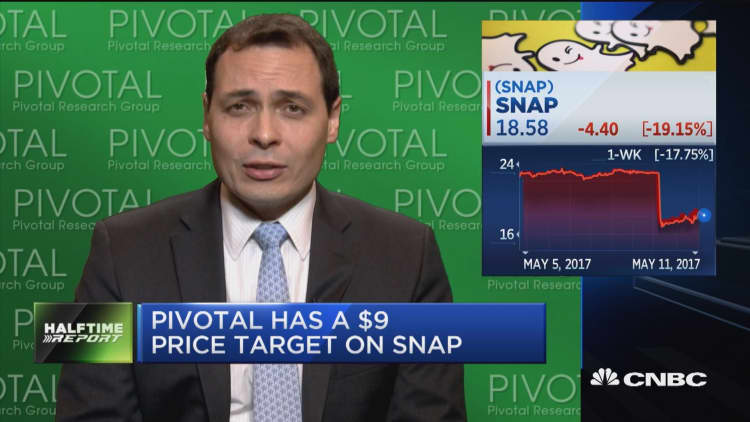
One of Snap 's Wall Street critics said he's reasonably positive on the stock in the long term — but Thursday's stock sell-off exposed one of the company's biggest risks.
"I don't think that the company needs to be concerned about that, except for the fact that a lot of employees who work there have been issued significant amounts of [restricted stock units] which are dependent upon a high stock price," said Brian Wieser, senior analyst at Pivotal. "The biggest risk for the company is, 'How do you manage a workforce whose compensation is largely stock-driven, if the stock comes down to earth?'"
Snap reported quarterly financial results for the first time as a public company on Wednesday night, revealing slower-than-expected revenue and user growth. Snap's $150 million in revenue declined from the $165.68 million in the fourth quarter — a traditionally busy time for the advertising business, as brands look to draw holiday shoppers.
"It was below my expectations," Weiser said. "To their credit, they did give us guidance saying that revenues would be below the fourth quarter in the first quarter. I just don't think any of us believed it should have happened. A company at this stage should not be experiencing cyclicality."
Investors vaporized a fifth of the company's value on Thursday, as the stock fell more than 20 percent.
Weiser lowered his price target to $9 a share, down from his previous estimate of $10 a share and well below Thursday's trading price of over $18 apiece. Weiser's price target is the lowest Snap estimate listed in FactSet; the average is $21.57 a share.
"I'm reasonably positive on the stock in the long run," Weiser said. "I just think it's massively overvalued."
Wall Street was hoping that Snap would report 167.3 million daily active users, but it reported 166 million. But that metric doesn't account for other measurements that matter in advertising, Weiser said, such as targeting ability, salesforce and monthly users.
"Snap is talking up the daily active user numbers. That's a lovely metric. But it just doesn't happen to be the relevant one for most marketers," Weiser said.
To be sure, Snap, like most other companies, warned about stock volatility during its initial public offering, writing: "The market price of our Class A common stock may be volatile or may decline steeply or suddenly regardless of our operating performance, and we may not be able to meet investor or analyst expectations. You may not be able to resell your shares at or above the initial public offering price and may lose all or part of your investment."
"It actually sounded to me like they've had five internal earnings calls ... where they've gone through this process before, and this was just another call," Weiser said. "Like there was no attempt to sell investors on the stock. There was no 'We're grateful that investors have placed such a significant valuation for us to grow into' kind of commentary."
Nonetheless, despite the competition for top engineers in Silicon Valley, Snap's headcount grew from 600 as of Dec. 31, 2015, to 1,859 as of Dec. 31, 2016, and is expected by management to continue to grow "for the foreseeable future."
"I don't think you want to overstate the consequences of one quarter," Weiser said.


